The firework season is upon us. Consideration should be given to how to protect our pets as best as possible.
Is your tortoise insured? Get a quote for £2,500 of vet fees, death and theft cover. Vet fee cover only is also available | We’ve been insuring exotic pets since 1996 | Check out our customer reviews on Feefo.
The most ideal situation for housing a tortoise is to set it up in an outdoor enclosure whenever possible. This can be a challenge in many climates.
A tortoise keeper must consider the climate, the specific tortoise needs and available space along with financial concerns among other things.
This can sometimes be difficult, but when properly thought out and executed can be very rewarding for both the tortoise keeper and the tortoise.
Jump to: How big does a tortoise enclosure need to be? | What materials can I build an outdoor tortoise enclosure with? | Where to build your tortoise enclosure | Building your tortoise enclosure | Enclosures for smaller tortoises | Your tortoise enclosure’s roof | Tortoise outdoor heating | Building a pond for your tortoise | Best substrate and plants for a tortoise enclosure
How big does a tortoise enclosure need to be?
For a tortoise that is hatchling to four inches an enclosure of 4ft x 8ft is suggested. Up to 10 individuals can be comfortably housed in this sized enclosure.
10ft x 20ft is a good size for an adult pair of Horsfields or Hermanns Tortoises.
It is always best to provide as much space as possible, although it is not practical or safe to place a tiny tortoise in a huge enclosure. So it is suggested to size the enclosure within reason.
Provide as much space as possible for tortoises over four inches with due thought given to the size, number of tortoises and the total space available.
Smaller enclosures can be used for hatchlings on a temporary basis such as when a tortoise keeper would like to give the indoor tortoises outdoor time. A movable 4ft by 4ft enclosure is suggested for this purpose.
You may like this: What setup do I need for my tortoise?
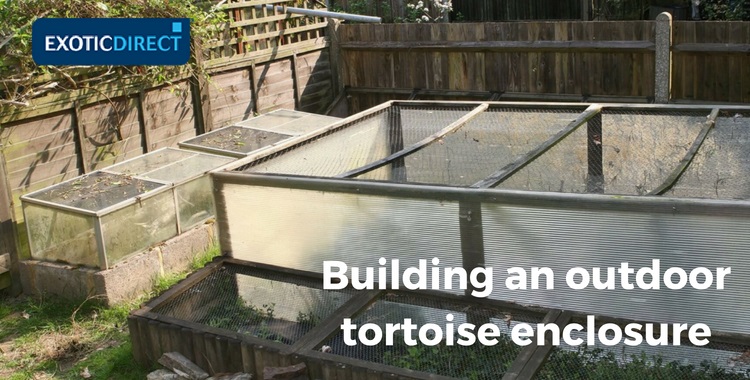 Three different enclosures – Cinder block base cold frames, Plastic panel enclosure covered by metal mesh, Garden edging covered by metal mesh.
Three different enclosures – Cinder block base cold frames, Plastic panel enclosure covered by metal mesh, Garden edging covered by metal mesh.
What materials can I build an outdoor tortoise enclosure with?
The enclosure can be made of materials such as:
- Stone
- Brick
- Concrete
- Wood
- Metal
- Fibreglass or a combination of the mentioned materials.
Which materials are used is going to be determined by available finances and the desired permanency of the enclosure.
- Wood: Any wood that it safe for people is safe for tortoises. Any of the more common woods are safe.Wood fencing or chain link fencing is usually the most practical and economical way to go. Wood is going to be the least expensive but will also need to be replaced every few years.It should be mentioned that when using chemical treated wood be sure to use child safe wood. This wood will expose the tortoise to minimal if any physical health risk.
Consideration should be given that when cutting treated wood, proper ventilation in the cutting area should be provided. It should be noted that when treated wood is cut the exposed fresh section has reduced protection which is susceptible to termite attack and rotting.
- Chain link fencing: Chain link fencing will last longer than wood but is a little more expensive when compared to wood.
- Stone, brick or concrete: These will provide the most permanent enclosure but it is also the most expensive.There is an exception to permanency of the enclosure when using brick such as cinder block or similar blocks.The larger blocks can be used as stand alone structures without the use of cement when used with smaller tortoises. The use of these blocks allows the tortoise keeper to move the enclosure around as needed.
Metal, plastic or fibreglass roofing panels can also be used for enclosure siding. Due caution should be used when cutting fibreglass because of the glass dust.
Is your tortoise insured? Get a quote for £2,500 of vet fees, death and theft cover. Vet fee cover only is also available | We’ve been insuring exotic pets since 1996 | Check out our customer reviews on Feefo.
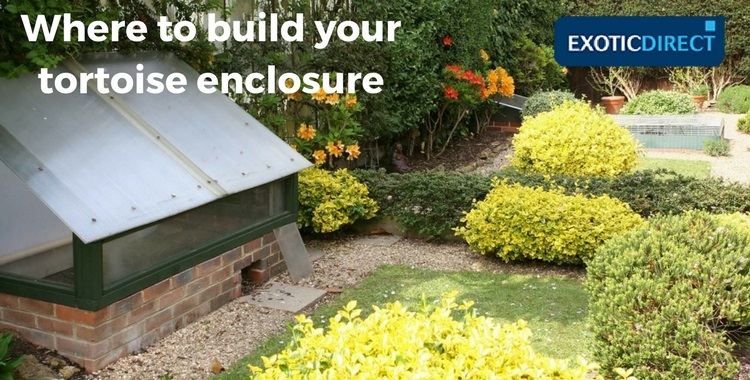 Plastic roofed coldframe. The plastic allows UV to pass through. Tortoises are allowed to hibernate in the coldframe during the winter. Location: Southern UK
Plastic roofed coldframe. The plastic allows UV to pass through. Tortoises are allowed to hibernate in the coldframe during the winter. Location: Southern UK
Where to build your tortoise enclosure
When constructing the enclosure it should be placed in an area that is out of public view such as in a back yard.
There should be a tall privacy fence to provide a relatively secure area from both the public and most wild animals which might harm the tortoise.
The enclosure should be located in a partially shaded area keeping in mind the different positions of the sun throughout the day.
If the yard does not have any shaded areas, then shade is easily made using some of the previously mentioned roofing panels.
Protect your tortoise from theft. Check out our article Keeping Tortoises Secure Outside
Building your Tortoise enclosure
The walls of the enclosure should be buried at least 12 inches below the surface to prevent tortoises from digging under the enclosure walls.
When burying the walls be sure to provide holes at the base of the walls at ground level every few feet to allow for drainage.
Another way to provide drainage is to use gravel at the base when covering the buried portion of the walls.
If using chain link fencing or similar, provide a visual barrier for the bottom 12 inches of the fencing by threading plastic through the links. These plastic strips can be purchased at the place where the fencing is available.
The walls of the enclosure should be at least two feet above ground level for most tortoises. Most tortoises can climb very well so you should provide a 12 inch triangular cap (or lip) at the corners of the enclosure to prevent the tortoises from climbing out.
Insure your tortoise for up to £2,500 of unexpected vet bills, death and theft. Find out more
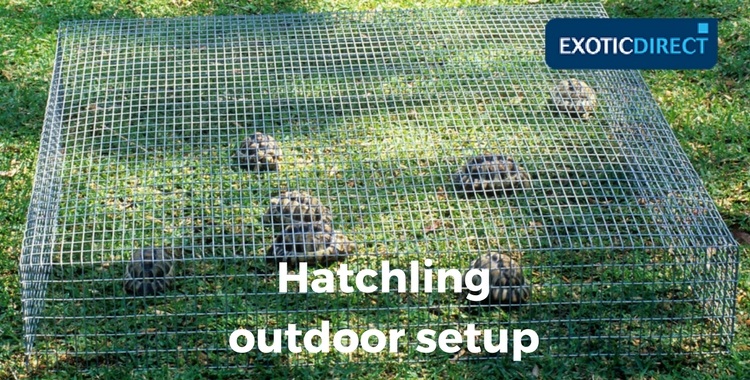 Hatchlings and smaller tortoises can be housed in a portable hardware cloth enclosure
Hatchlings and smaller tortoises can be housed in a portable hardware cloth enclosure
Enclosures for hatchlings and smaller tortoises
For smaller tortoises a simple 12 inch high and 4ft square frame can be constructed to place in the yard where ever needed.
This box can be constructed out of what is called hardware cloth. This is a heavy metal mesh that can be formed into the box by cutting out a 6 inch square out of each of the corners of a 4ft square sheet, and bending over the sides of the frame.
You should make sure to either shade a portion of the enclosure or be careful to place the enclosure in a partially shaded area, keeping in mind the current and future position of the sun.
Your tortoise enclosure’s roof
During warmer weather the roof of the structure should have vents to allow the heat out. This kind of setup allows the tortoise to have a longer outdoor season.
Roofing can be made from panels, or regular wood covered with roofing tar paper or shingles.
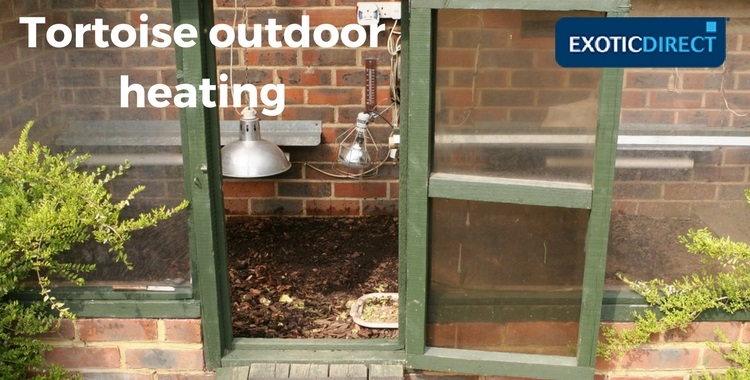 Larger coldframe-supplemental heating is provided by infrared bulbs and heating tubes
Larger coldframe-supplemental heating is provided by infrared bulbs and heating tubes
Tortoise outdoor heating
Some common outdoor heat sources are ceramic heat emitters or infra-red (IR) heating panels which are suspended from overhead and controlled by either a rheostat or thermostat.
The strength of the heating element is going to depend on the size of the enclosure and the ambient temperature outdoors.
300w is a good average. Make sure the heat source is far enough away so as not to burn the animal. Ceramic heat emitters or infra-red heating panels can be safer, reducing the risk of burns, however many keepers successfully use infra-red bulbs. They should be used with extreme caution.
Heating should be hung from either the top or side of the enclosure. Heat mats can be used on the enclosure floor.
The heat source can be added to the hide, and it’ll help extend your tortoises outdoor season.
You can buy ceramic heat emitters and infra-red bulbs from the Northampton Reptile Centre.
Tortoise habitat decorations
You can use:
- Flagstones
- Tunnels
- A hide
It is always best to try and keep the enclosure as simple or practical as possible when adding decoration.
- Flagstones: When placing objects it is a good idea to add the kind of furnishings that do not take up a great deal of space. For example, flat rocks called flagstones that can be placed in such a manner that the tortoise can climb on or under.
- Tunnels: Creating tunnels the tortoise can go over and through is another suggestion to increase space and behavioural enrichment.
The furnishings also add visual barriers which is important to allow a tortoise to escape any unwanted advances where more than one tortoise is being kept together.
Be careful to place these structures in such a way so that if the tortoise should fall off an edge and flip over it has access to something that it can grasp to help right itself.
- Hide: One essential piece of furniture is going to be the hide. This is going to be a place where the tortoise can escape the weather and feel secure when resting. It is also where higher humidity can be provided.
The hide can be as simple as a closed box with one or more holes cut in the side large enough for the tortoise to access the hide.The hide can also be as elaborate as a cold frame or green house, which are glass or clear plastic paneled structures. What is good about the cold frame is that during cooler weather they maintain a good naturally warm temperature through the action of the sun shining through the glass.Most tortoise keepers in cooler climates have outdoor enclosures with a cold frame.
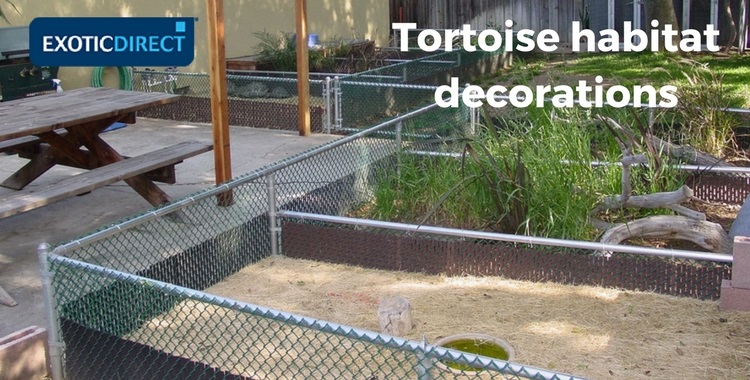 One inch square plastic coated chain link fence enclosure
One inch square plastic coated chain link fence enclosure
Building a pond for your tortoise
A pond is easily constructed using cement by shaping a hole in the ground and forming the cement to conform to the hole. Make sure to slope the sides to allow the tortoise to easily access the water.
Gravel is set into the sides to allow easier footing to get in and out of the pond or trough.
The water containers are cleaned by way of rinsing with a water hose or providing a drain that can be plumbed into the bottom of the container before the concrete is poured.
The water trough or pond can be used to provide water and soaking for the tortoise.
With the furnishings complete the next step is to add plants and landscaping.
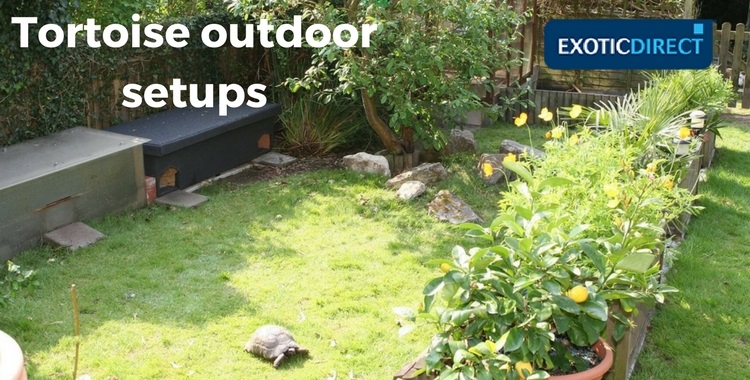 Greenhouse along with one wooden house covered by roofing cloth and another made out of plastic panel
Greenhouse along with one wooden house covered by roofing cloth and another made out of plastic panel
Best substrate and plants for a tortoise enclosure
Tortoises are relatively intuitive animals in that they seem to know what they can or cannot eat but it is a suggested that the tortoise keeper provide plants that are known to be useful to the tortoise.
For the substrate it is suggested that grasses such as Bermuda or Fescue be used because most tortoises seem to like this kind of grass for grazing and it is relatively easy to grow.
Another good grass is called Orchard grass. This grass is made up of a multitude of grasses which would provide a larger variety of grasses.
There are many places that sell weeds such as Dandelion and Plantain which are very good for tortoises in general.
Shrubs and bushes can be added for cover. Recommended cover plants are Hibiscus and Honeysuckle among others that are hardy to the particular area the enclosure is being set up in.
The choices for plants you can add are endless. What a tortoise keeper chooses to plant is going to depend on the area they are going to live in. Check with your local garden shop for what is practical for your particular area.
Do not be overly concerned for what is safe or not but try to focus on those that are safe for mammals in general.
Check out our article Tortoise Food and Diet Advice
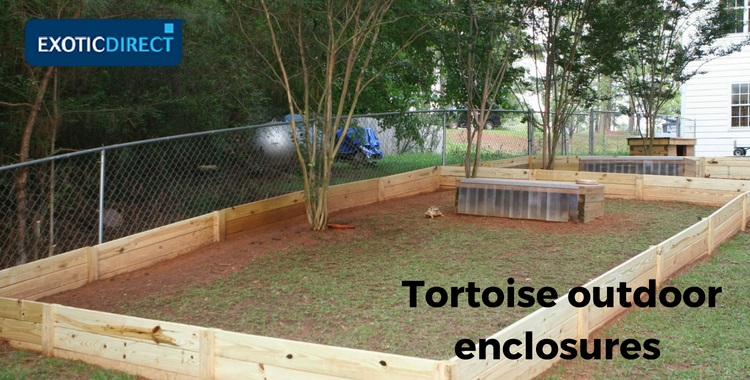 A treated wood enclosure. Hide is heated by an all weather heat mat
A treated wood enclosure. Hide is heated by an all weather heat mat
What temperature do tortoises need to be kept at?
A good basic guide for when to safely put the tortoise outdoors would be if the night time temperatures are 50 degrees Fahrenheit (10 degrees Celsius) or greater. This guide can be adjusted based on the construction of the outdoor enclosure.
Depending on whether the setup is put together just right, if you live in a temperate zone, and the local climate, Tortoises can be maintained outdoors for most, if not all of the year. This doesn’t necessarily apply to UK climates.
And Tortoises can be maintained outdoors the whole year, if the winter temperatures average above freezing and supplemental heating is provided.
What many tortoise keepers do is provide a hybrid outdoor enclosure. This would consist of a shed or room with open access to an outdoor enclosure.
The room would be large enough to house the tortoise during colder weather. The access to the outdoor pen would have a door that could lock the tortoise in during periods or lower temperatures, and be left open when the temperatures are more favorable.
This further increases the choices the tortoise has to access a proper climate. An outdoor enclosure is not essential to tortoise keeping but it provides a space for the tortoise that will make it easier to raise a happy and healthy tortoise.
It is always better to provide an outdoor enclosure when ever possible.
The benefits of an outdoor enclosure
What is nice about maintaining tortoises in an outdoor enclosure is that most species will adapt to the described setup in this article.
All tortoises seem to prefer a relatively humid portion of the environment to rest while at the same time they will forage in the dryer portion of the habitat or whatever habitat that is available.
This takes a great deal of pressure off the tortoise keeper because the tortoise is given a full range of choices in both environmental conditions and nutritional selection.
It is important to realize that the size of the tortoise and the number of tortoises in the enclosure should be kept to a minimum relative to the size of the enclosure to reduce the stress on the tortoises being kept.
If the setup is put together just right the tortoises will thrive with minimal care, with the tortoise keeper only having to provide water and supplemental feeding.
Ed Pirog is a tortoise expert and author, having written several books on tortoise care. He also set up the popular Tortoise Keepers Facebook Group, which has over 21,000 members worldwide.
Insure your tortoise for £2,500 of vet fees, death and theft. Vet fee cover only is also available | We’ve been insuring exotic pets since 1996 | Check out our customer reviews on Feefo.
Alternatively, call us now on 0345 982 5505

